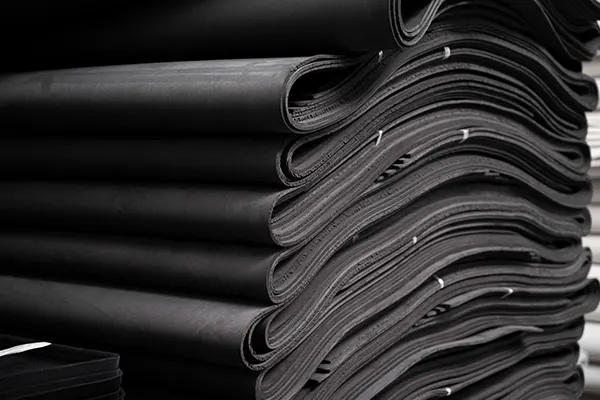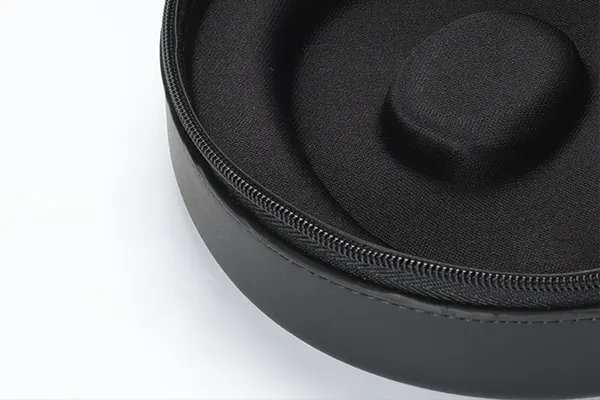Nel regno dei materiali, Eva e PVC ricoprono una posizione significativa a causa della loro natura versatile e delle diverse applicazioni. Mentre entrambi i materiali hanno le loro caratteristiche e vantaggi distintivi, Comprendere le differenze chiave è cruciale per prendere decisioni informate in vari settori. In questo articolo, approfondiremo la composizione, proprietà, e applicazioni di EVA e PVC. Svelando i misteri dietro questi materiali, Speriamo di fornirti le conoscenze necessarie per scegliere il materiale giusto per le tue esigenze specifiche.
Cos'è il materiale EVA?

EVA, un acronimo di acetato di etilene-vinile, è un copolimero realizzato dalla polimerizzazione di monomeri acetato di etilene e vinile. Questa composizione è ciò che dà a Eva le sue proprietà uniche. L'etilene offre un'eccellente tenacia e flessibilità, mentre il vinile acetato migliora l'adesione e la stabilità termica. Inoltre, Il rapporto tra etilene e contenuto di acetato di vinile determina la durezza e la morbidezza del materiale EVA. Generalmente, Maggiore è il contenuto di acetato di vinile, il più morbido e flessibile diventa Eva.
Cos'è il materiale PVC?

PVC, o polivinil cloruro, è un polimero termoplastico sintetico composto da unità ripetute di cloruro di vinile. La composizione di PVC concede la capacità di resistere a una varietà di condizioni ambientali, rendendolo uno dei materiali più versatili del settore. La sua eccellente resistenza chimica, Proprietà meccaniche, e la durata ha reso il PVC un punto fermo in numerosi settori.
EVA contro. PVC: Processo di produzione
Materiali EVA sono fabbricati attraverso un processo noto come il Polimerizzazione ad alta pressione di monomeri di etilene e acetato di vinile. Questo processo prevede l'uso di un catalizzatore per iniziare la reazione, con conseguente formazione di catene di copolimeri EVA. La composizione del materiale finale viene determinata controllando attentamente il rapporto tra etilene e vinile acetato durante il processo di polimerizzazione.
D'altra parte, Il PVC viene prodotto attraverso un processo chiamato polimerizzazione della sospensione. In questo metodo, I monomeri del cloruro di vinile sono sospesi in acqua, e viene introdotto un iniziatore radicale libero per iniziare la reazione di polimerizzazione. La resina in PVC risultante viene quindi elaborata ulteriormente per raggiungere le caratteristiche e le proprietà desiderate. Vale la pena notare che ci sono tecniche di produzione alternative come la polimerizzazione emulsiva e la polimerizzazione sfusa, ognuno con i propri vantaggi e caratteristiche.
EVA contro. PVC: Durata


Eva mostra una notevole resilienza e resistenza all'usura, rendendolo una scelta eccellente per prodotti come Caso Eva che subiscono un uso frequente e richiedono una durata. La struttura del copolimero di EVA fornisce un equilibrio tra resistenza e flessibilità, permettendolo di resistere alle forze esterne senza deformazione o rottura. La sua terapia intrinseca garantisce che i materiali EVA mantengano la loro forma e integrità anche in condizioni difficili.
In confronto, Il PVC possiede una forza e una resistenza eccezionali, permettendolo di resistere a carichi pesanti e stress fisico. Le forti forze intermolecolari di PVC offrono un'eccellente resistenza all'impatto, renderlo adatto per applicazioni che richiedono integrità strutturale. Che si tratti di tubi, Cavi, o materiali di copertura, La durata di PVC lo rende una scelta affidabile per le soluzioni di lunga durata.
EVA contro. PVC: Flessibilità ed elasticità
La flessibilità intrinseca di Eva è uno dei suoi vantaggi principali. A causa dell'elevato contenuto di acetato di vinile, Eva mostra una natura morbida e flessibile, permettendolo Conformare a varie forme e contorni. Questa versatilità rende Eva un materiale ideale per i prodotti che richiedono flessibilità e facilità d'uso, come calzature, attrezzature sportive, e materiali di imballaggio.
Al contrario, L'elasticità di PVC lo consente di farlo recuperare la sua forma originale dopo la deformazione. Questa caratteristica rende il PVC adatto alle applicazioni che comportano la flessione o lo stretching, come strutture gonfiabili, tubi, e guarnizioni. La capacità di PVC di mantenere la sua elasticità su una vasta gamma di temperature espande le sue potenziali applicazioni in diversi settori.
EVA contro. PVC: Resistenza chimica
I materiali EVA possiedono un'eccellente resistenza a una vasta gamma di sostanze chimiche e solventi. Questa resilienza rende Eva una scelta ideale per i prodotti che entrano in contatto con varie sostanze, compreso agenti di pulizia, oli, e acidi. Inoltre, La resistenza di Eva a muffa e muffa La crescita migliora ulteriormente la sua durata e longevità.
PVC, Simile a Eva, presenta una resistenza chimica impressionante. Può resistere all'esposizione acidi, alcali, e altre sostanze corrosive senza degrado. Questa qualità consente l'utilizzo del PVC in applicazioni critiche in cui l'esposizione chimica è una preoccupazione, come contenitori di stoccaggio chimico, Attrezzatura di laboratorio, e sistemi di tubi.
EVA contro. PVC: Resistenza all'acqua

In termini di resistenza all'acqua, Eva si rivela altamente efficace. La struttura del copolimero di Eva, con la sua costruzione di schiuma a cellule chiuse, impedisce l'assorbimento dell'acqua e funge da barriera contro l'umidità. Questa proprietà rende Eva un materiale ideale per applicazioni impermeabilizzanti in settori come la costruzione, marino, e attrezzatura esterna.
Allo stesso modo, Il PVC vanta capacità di impermeabilizzazione eccezionali. A causa della sua bassa permeabilità e resistenza all'assorbimento dell'acqua, Il PVC è una scelta ottimale per le applicazioni in cui la protezione dell'umidità è cruciale. Dalle membrane di copertura ai vestiti da pioggia, Le proprietà impermeabilizzanti di PVC garantiscono l'integrità e la longevità dei prodotti finali.
EVA contro. PVC: Resistenza UV
Una delle caratteristiche intriganti di Eva è la sua Resistenza alle radiazioni UV. La capacità di Eva di resistere all'esposizione prolungata alla luce solare senza degradazione lo rende una scelta eccellente per le applicazioni all'aperto. La resistenza ai raggi UV garantisce che i materiali EVA mantengano le loro proprietà fisiche ed estetica, anche se esposto alla dura luce solare per periodi prolungati. Questa qualità ha portato all'uso di EVA nei mobili per esterni, pannelli solari, e componenti automobilistici.
Allo stesso modo, PVC possiede notevole resistenza ai raggi UV, renderlo adatto per applicazioni che richiedono un'esposizione prolungata alla luce solare. L'aggiunta di stabilizzatori UV durante il processo di produzione migliora la resilienza di PVC alle radiazioni UV, Garantire che mantenga la sua integrità strutturale e l'aspetto nel tempo. Le applicazioni che beneficiano della resistenza UV di PVC includono i profili delle finestre, scherma, e segnaletica esterna.
EVA contro. PVC: Isolamento termico

Eva Materials Exhibit Proprietà di isolamento termico notevole, renderli molto ricercati in settori che richiedono il controllo della temperatura. La struttura a cellule chiuse di Eva riduce il trasferimento di calore, fornendo così un eccellente isolamento contro le temperature fredde e calde. Questa caratteristica trova applicazioni in settori come l'imballaggio, automobile, e costruzione.
In alternativa, PVC possiede un livello moderato di isolamento termico. Sebbene non efficace come EVA in termini di isolamento, PVC offre ancora notevole resistenza al calore. La sua capacità di mantenere le sue proprietà meccaniche a temperature elevate rende il PVC adatto per applicazioni che comportano il trasferimento di calore, come l'isolamento elettrico, tubi, e rivestimento.
EVA contro. PVC: Costo
Quando si considera la fattibilità economica dell'utilizzo di materiali EVA, È essenziale valutare i vantaggi offerti dal materiale. Mentre Eva può avere un Costo iniziale più elevato Rispetto ad altri materiali, La sua eccellente durata, flessibilità, e la resistenza alle sostanze chimiche e alle radiazioni UV contribuisce al suo costo-efficacia a lungo termine. La longevità dei prodotti realizzati in EVA garantisce una ridotta manutenzione e costi di sostituzione, rendendolo un economicamente praticabile Scelta per vari settori.
D'altra parte, Offerte in PVC costo-efficacia A causa dei suoi bassi costi di materia prima e produzione. Inoltre, La durata di PVC e la lunga durata della vita contribuiscono alla sua efficacia in termini di costi complessivi. La capacità di resistere alle condizioni meteorologiche estreme e resistere al degrado chimico riduce i costi di manutenzione e estende la durata della durata dei prodotti realizzati in PVC.
EVA contro. PVC: Impatto ambientale

L'eco-compatibilità di Eva sta nella sua Riciclabalità. I materiali EVA sono prontamente riciclabili, Abilitare il riutilizzo delle risorse e ridurre i rifiuti. Inoltre, Alcuni produttori hanno iniziato a produrre EVA utilizzando risorse rinnovabili, minimizzare ulteriormente l'impatto ambientale. La riciclabilità e i metodi di produzione sostenibili associati all'EVA lo rendono una scelta consapevole dell'ambiente.
Le considerazioni ambientali di PVC ruotano attorno al suo processo di produzione, potenziale tossicità, e capacità di riciclaggio. Mentre la produzione in PVC genera gas cloro, Vengono prese misure per ridurre al minimo il rilascio nell'ambiente. Inoltre, Sono stati fatti progressi nello sviluppo di tecniche di riciclaggio alternative per PVC, consentendo un uso più sostenibile del materiale. La valutazione dell'impatto ambientale del PVC implica considerare l'intero ciclo di vita del materiale, compresa la sua durata e riciclabilità.
EVA contro. PVC: Applicazioni e industrie
Materiali EVA Trova l'applicazione in vari settori, compreso produzione di calzature, articoli sportivi, automobile, confezione, e persino l'assistenza sanitaria. La flessibilità, durabilità, e la resistenza alle sostanze chimiche e alle radiazioni UV rendono Eva un materiale versatile che può essere adattato a esigenze specifiche. Il suo uso nelle suole di scarpe, Eva schiuma di schiuma, Case di protezione e attrezzature mediche mettono in mostra la sua adattabilità in diversi settori.
Le applicazioni di PVC abbracciano una vasta gamma di settori, copertura costruzione, elettrico, automobile, e assistenza sanitaria. La durata del materiale, resistenza chimica, e il rapporto costo-efficacia contribuisce al suo ampio utilizzo. PVC si fa strada in cornici delle finestre, tubi, Cavi, sacche di sangue, e molti altri prodotti che richiedono una combinazione di resilienza e convenienza.
EVA contro. Materiali in PVC, Che è meglio?
Quando si tratta di selezionare il materiale giusto per una particolare applicazione, La scelta tra Eva (Etilene vinile acetato) e PVC (Polivinil cloruro) sorge spesso. Entrambi i materiali possiedono proprietà uniche, rendendoli adatti a vari settori e scopi.
Benefici per materiali EVA:
- Flessibilità ed elasticità
- Durata e resilienza
- Resistenza chimica
- Resistenza all'acqua e impermeabilizzazione
- Resistenza UV
- Isolamento termico
- Riciclabilità e cordialità ambientale
Benefici del materiale in PVC:
- Forza e resistenza
- Resistenza chimica
- Resistenza all'acqua e impermeabilizzazione
- Resistenza UV
- Resistenza al calore ragionevole
- Costo-efficacia
- Riciclabilità e sostenibilità
Per progetti che danno la priorità alla flessibilità, facilità d'uso, e riciclabilità, Eva potrebbe essere la scelta preferita. D'altra parte, quando durabilità, forza, e il rapporto costo-efficacia sono importanti considerazioni, Il PVC potrebbe essere l'opzione migliore. È essenziale valutare attentamente le proprietà e le limitazioni uniche di ciascun materiale e considerare come si allineano con l'uso previsto per determinare quale materiale è il più adatto.
Conclusione
Insomma, Comprendere le differenze chiave tra EVA e materiale in PVC è essenziale per prendere decisioni informate in vari settori. Mentre Eva mostra una notevole flessibilità, Resistenza UV, e riciclabilità, Il PVC vanta un'eccellente durata, resistenza chimica, ed efficacia in termini di costi. Valutando i requisiti specifici di ciascuna applicazione, Si può scegliere il materiale più adatto per ottenere risultati desiderati. Che si tratti della versatilità di Eva o dell'affidabilità del PVC, La scelta alla fine dipende dalla ricerca del giusto equilibrio tra funzionalità, longevità, e fattibilità economica.
















